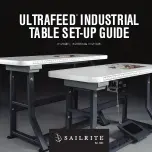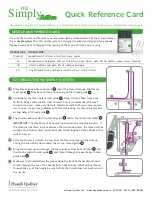
24
2
Tensión del hilo
La tensión del hilo afectará a la calidad de las
puntadas. Cuando cambie de tela o de hilo, es
posible que necesite ajustar la tensión del hilo.
Recuerde
●
Antes de comenzar a cambiar los ajustes de
tensión, asegúrese de que el hilo superior y
la bobina están colocados correctamente.
●
Antes de comenzar a coser, recomendamos
que haga una prueba en un retal.
■
Tensión adecuada
Una tensión adecuada es importante, puesto que
un exceso o defecto de la misma afectará a la
calidad de la costura y la tela podría fruncirse.
■
El hilo superior está demasiado tenso
Aparecerán ondas en la superficie de la tela.
Nota
●
Si el hilo de la bobina no se ha insertado
correctamente, el hilo superior puede estar
demasiado tenso.
En este caso, consulte “Enhebrado del hilo
inferior” (página 11) y vuelva a insertar la
bobina.
Solución
Reduzca la tensión girando
el disco de control de la
tensión superior a un
número inferior.
■
El hilo superior está demasiado flojo
Aparecerán ondas en el revés de la tela.
Nota
●
Si el hilo superior no se ha enhebrado
correctamente, podría estar demasiado
flojo. En este caso, consulte “Hilo superior”
(página 13) y vuelva a enhebrarlo.
Solución
Aumente la tensión girando
el disco de control de la
tensión superior a un
número superior.
■
La tensión de la bobina es muy
floja
Pueden aparecer ondas en la superficie de la tela
cuando se cose con tela fina y con hilo fino.
Solución
Reduzca la tensión girando
el disco de control de la
tensión superior a un
número inferior.
Si el problema continúa, aumente la tensión
en la bobina girando el tornillo ovalado hacia
la derecha con un destornillador pequeño.
Asegúrese de no girar el tornillo más de una
vuelta completa. Además, asegúrese de girar
el tornillo a su posición original antes de
volver a utilizar la máquina.
Nota
●
La tensión del hilo de la bobina se ha
ajustado en fábrica para un uso general.
Para la mayoría de las aplicaciones de
costura no es necesario ningún ajuste.
1
2
3
4
a
Revés
b
Superficie
c
Hilo superior
d
Hilo inferior
1
2
3
4
5
a
Revés
b
Superficie
c
Hilo superior
d
Hilo inferior
e
Ondas en la
superficie de la tela
1
2
3
4
5
a
Revés
b
Superficie
c
Hilo superior
d
Hilo inferior
e
Ondas en el
revés de la tela
1
2
3
4
5
a
Revés
b
Superficie
c
Hilo superior
d
Hilo inferior
e
Ondas en la
superficie de la tela
Summary of Contents for LX-3125
Page 48: ......
















































